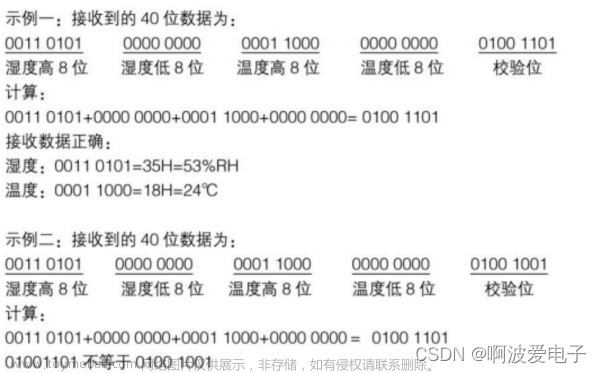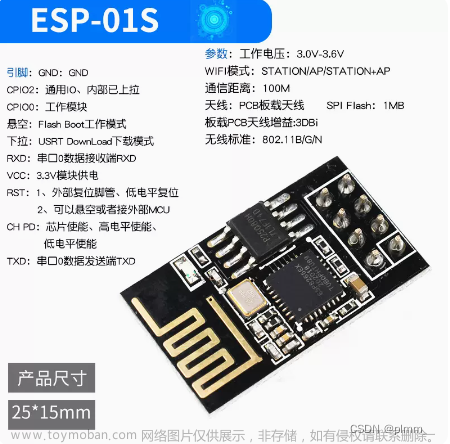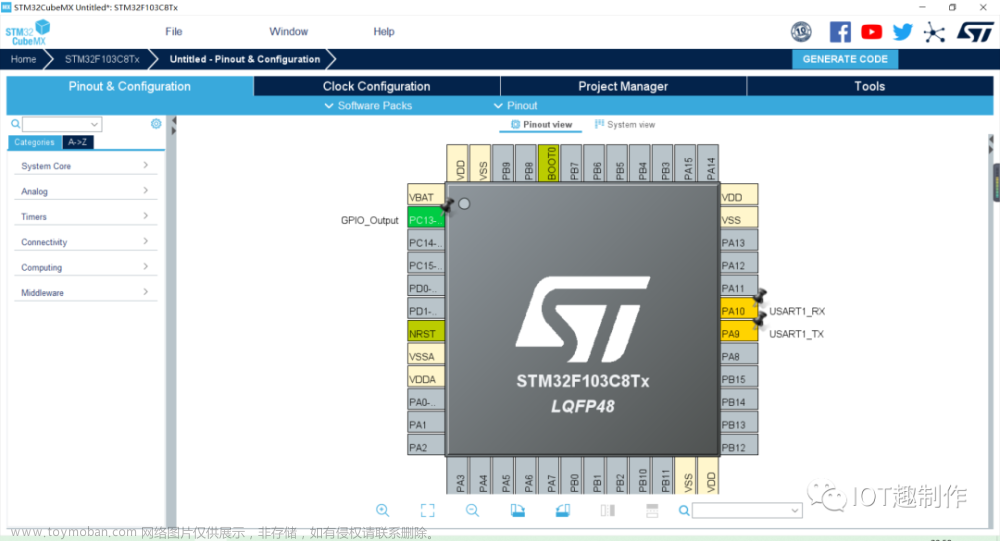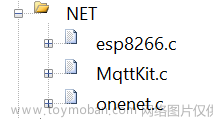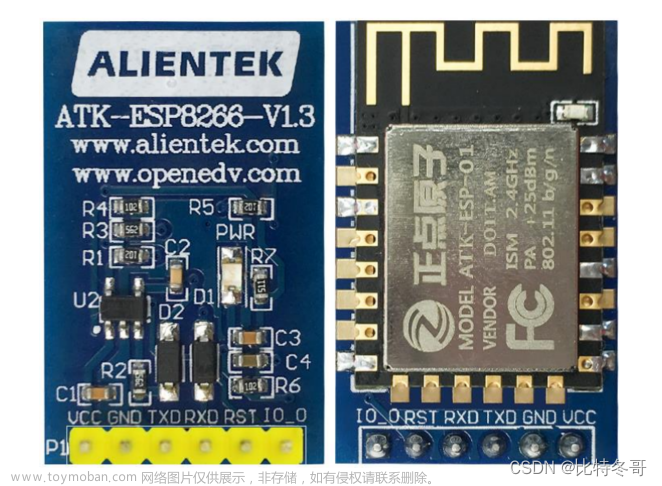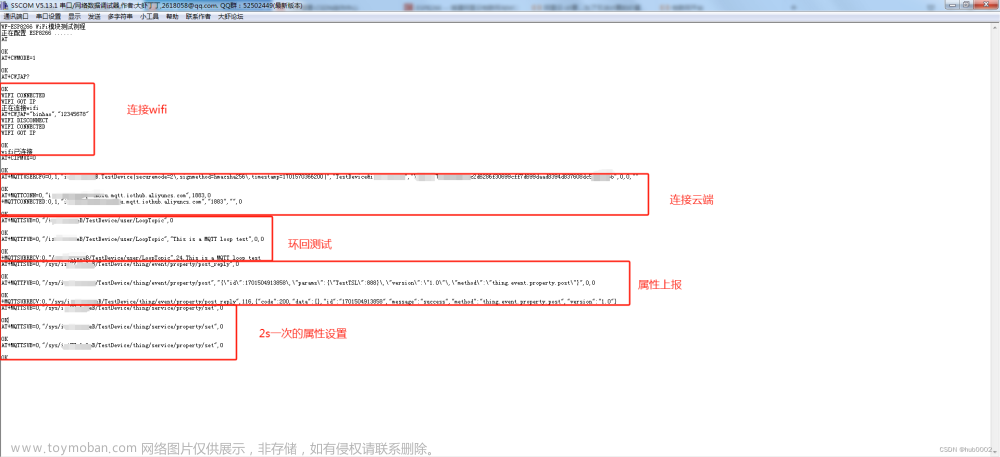目录
前言
一、stm32cubeMX的串口配置
二、空闲中断+dma接收
三、ESP8266.c和ESP8266.h
ESP8266.h
ESP8266.c
注意事项
四、与手机通信例程
步骤:
例程代码main.c
运行结果
五、相关问题
总结
相关的app和源码
前言
前提:
1.掌握串口通信和ESP8266的使用方法
串口通信:单片机串口通信不理解?STM32的USART和UART差在哪里?几分钟给你讲清楚!(STM32教程基于HAL库和CUBEIDE)_哔哩哔哩_bilibili
ESP8266的使用
STM32HAL库使用ESP8266模块_hal esp8266_啵啵520520的博客-CSDN博客
2.这次采用的空闲中断+dma来和ESP8266通信,接收ESP8266发来的不定长数据
STM32 hal库串口空闲中断最新用法_hal 串口空闲中断_北世安的博客-CSDN博客
3.板子是魔女开发板,主控芯片是STM32F103RCT6
4.文章末尾会附带我写好的重定向和esp8266通信代码,调用api即可
一、stm32cubeMX的串口配置
采用串口1与pc通信
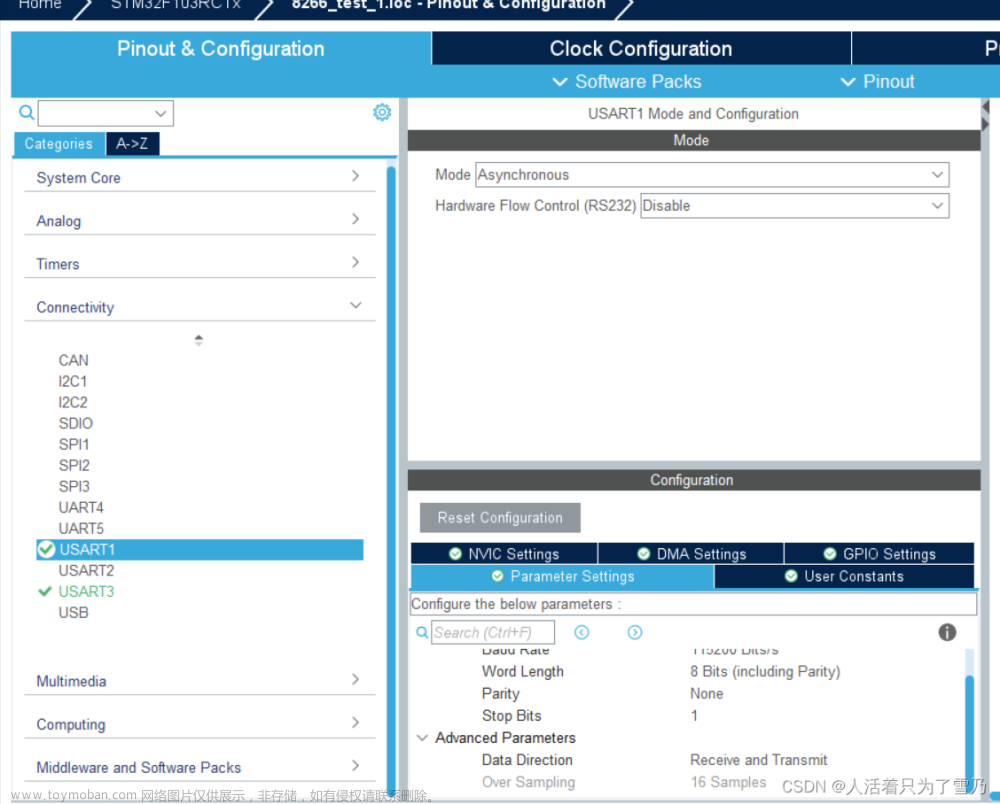
采用串口3与8266通信

开启dma和中断,把串口3的rx的dma通道优先级调高(比串口1的rx的dma通道的优先级高就行)
如果没调高,可能会出现没能及时收到8266回复的信息的问题。

二、空闲中断+dma接收
HAL_UARTEx_ReceiveToIdle_DMA(&huart1,PCRxbuf,sizeof(PCRxbuf));//使能空闲dma中断
HAL_UARTEx_RxEventCallback(UART_HandleTypeDef *huart, uint16_t Size)//中断回调函数当开启空闲接收中断后,当2个字节的时间内没有新的数据来,或者到达你设置的最大接收值,就会进入到这个中断回调函数中,其中Size就是此次接收到的函数
三、ESP8266.c和ESP8266.h
ESP8266.h
#ifndef _ESP_8266_H
#define _ESP_8266_H
#include "main.h"
#include <stdio.h>
#define LENGTH 1024
extern uint8_t ESP8266Rxbuf[LENGTH];//存放来自8266的回复
void ESP8266_Init(UART_HandleTypeDef *uart);//初始化函数
uint8_t sendATTo8266(uint8_t *str);//向8266发送AT指令
uint8_t sendStringTo8266(uint8_t *str);//向8266发送字符串
void recStringBy8266(uint16_t Size);//接收来自8266的字符串
void linkWifi(char *ssid,char *pwd);//连接wifi,ssid wifi:名字,pwd:wifi密码
void linkTCP(char *addr,char *port);//建立TCP连接,addr:IP地址 port:端口
void StartCipsend(char *addr,char *port);//开始透明传输
#endif
ESP8266.c
#include "ESP8266.h"
#include "dma.h"
#include "usart.h"
#include "gpio.h"
#include "string.h"
UART_HandleTypeDef *uart8266;
uint8_t ESP8266Rxbuf[LENGTH];//存放8266的消息
uint8_t CIPMODE=0;//透明传输模式标志位
uint8_t TESTMODE=0;//测试模式标志位
int replyFlag=0;//8266回复标志位
/*8266初始化*/
void ESP8266_Init(UART_HandleTypeDef *uart){
uart8266=uart;
HAL_Delay(2000);//8266上电后要等待一段时间才能正常运行
HAL_UART_Transmit(uart8266,"AT+RESTORE\r\n",12,0xff);//发送恢复出厂化设置的指令
HAL_Delay(5000);//等待恢复出厂设置完成
HAL_UARTEx_ReceiveToIdle_DMA(uart8266,ESP8266Rxbuf,sizeof(ESP8266Rxbuf));//开启接收8266的消息
}
/*检查AT指令是否合规*/
/*0 不合规 1 合规*/
uint8_t checkAT(uint8_t *str,int len){
int i=0;
for(i=0;i<len;i++){
if(*(str+i)=='\r'||*(str+i)=='\n'){
if(i<len-2){
return 0;
}
else if(*(str+i)=='\r'&&*(str+i+1)=='\n'){
return 1;
}
}
}
return 0;
}
/*发送AT指令*/
/*0 发送失败,1 发送成功*/
uint8_t sendATTo8266(uint8_t *str){
int len=strlen((char *)str);
if(0==checkAT(str,len)){
printf("AT error\n");
return 0;
}
else{
printf("AT right\n");
if(HAL_OK==HAL_UART_Transmit(uart8266,str,len,0xff)){
printf("%.*s send to 8266 ok!\n",len-2,str);
return 1;
}
else{
printf("%.*s send to 8266 error!\n",len-2,str);
return 0;
}
}
}
/*接收来自8266的AT消息回复*/
void recATBy8266(uint16_t Size){
HAL_UART_DMAStop(uart8266);//先暂停接收
// printf("wifibuf:%s\n",WifiRxbuf);
int i=0;
do{ //判断消息里有没有OK或者ERROR,8266回复的消息里都会带有OK或者ERROR
if(ESP8266Rxbuf[i]=='O'&&ESP8266Rxbuf[i+1]=='K'){
memset(ESP8266Rxbuf,0,sizeof(ESP8266Rxbuf));
HAL_Delay(2000);//收到OK,延时,等后续的消息发送完成
printf("8266 say OK\r\n");
replyFlag=1;//收到回复的标志位置1
// printf("OK replyFlag:%d\n",replyFlag);
HAL_UARTEx_ReceiveToIdle_DMA(uart8266,ESP8266Rxbuf,sizeof(ESP8266Rxbuf));//开启下次接收
return;
}
else if(ESP8266Rxbuf[i]=='E'&&ESP8266Rxbuf[i+1]=='R'&&ESP8266Rxbuf[i+2]=='R'&&ESP8266Rxbuf[i+3]=='O'&&ESP8266Rxbuf[i+4]=='R'){
HAL_UART_Transmit(uart8266,"AT\r\n",4,0xff);//如果返回是error,那么下一条还是发送失败,所以用个AT指令来抵掉这次发送失败
HAL_Delay(4000);//延时等抵消成功
printf("\n8266 say ERROR\r\n");
replyFlag=2;//收到回复的标志位置2
// printf("ERROR replyFlag:%d\n",replyFlag);
memset(ESP8266Rxbuf,0,sizeof(ESP8266Rxbuf));
HAL_UARTEx_ReceiveToIdle_DMA(uart8266,ESP8266Rxbuf,sizeof(ESP8266Rxbuf));
return;
}
}while(++i<Size);
/*8266回复的消息有些是分包发回的,即OK或者ERROR可能在后续的包里面*/
memset(ESP8266Rxbuf,0,sizeof(ESP8266Rxbuf));//清空接收下一数据包
HAL_UARTEx_ReceiveToIdle_DMA(uart8266,ESP8266Rxbuf,sizeof(ESP8266Rxbuf));//开始接收下一数据包
}
/*向8266发送字符串*/
/*0:发送失败,1:发送成功*/
uint8_t sendStringTo8266(uint8_t *str)
{
uint16_t Size = strlen((char *)str);
if(CIPMODE==1){//判断是否为透明传输模式,是的话直接进行发送
HAL_UART_Transmit(uart8266,str,Size,0xff);
if(!strcmp((char *)str,"+++")){//如果发送的是“+++”(不带\r\n就是关闭透明传输模式)
printf("\nclose CIPSEND\n");
CIPMODE=0;
}
return 1;
}
/*这个是我编写的调试模式,不用发给8266*/
/*调试模式下,就相当于PC直接与8266通信*/
else if(!strcmp((char *)str,"AT+TESTMODE\r\n")){
if(TESTMODE==0){
printf("open testmode\n");
TESTMODE=1;
}
else{
printf("close testmode\n");
TESTMODE=0;
}
return 0;
}
if(HAL_OK==HAL_UART_Transmit(uart8266,str,Size,0xff)){//发送成功
if(!strcmp((char *)str,"AT+CIPSEND\r\n")){//判断是否是开启透明传输模式的指令
printf("open CIPSEND\n");
uint32_t t=0;
while(replyFlag==0){//等待8266回复
HAL_Delay(1000);
t++;
if(t>40){
printf("open CIPSEND error\n");
return 0;
}
}
CIPMODE=1;//收到回复就把标志位置1
}
return 1;
}
else{
return 0;
}
}
/*向8266发送消息并且确认回复*/
/*0:发送失败或者没收到回复或者回复ERROR*/
/*1:发送成功且收到OK回复*/
uint8_t sendTo8266(uint8_t *str){
if(sendStringTo8266(str)){
uint32_t t=0;
// uint32_t t=4000*3127;//臭狗屎,慎用,用于调试,看看回复标志位什么时候置1。
// while(t--){
// printf("t=%d flag=%d\n",t,replyFlag);
// }
while(replyFlag==0){//等待回复
HAL_Delay(1000);
t++;
if(t>40){//超时
printf("time out error\n");
return 0;
}
}
if(replyFlag==1){//判断是不是OK回复。
replyFlag=0;
return 1;
}
else{
printf("error\n");
replyFlag=0;
return 0;
}
}
else{
replyFlag=0;
return 0;
}
}
/*处理来自8266的消息*/
void recStringBy8266(uint16_t Size)
{
if(CIPMODE!=0||TESTMODE!=0){//如果是透明传输模式或者调试模式,直接显示
printf("%s\n",ESP8266Rxbuf);
memset(ESP8266Rxbuf,0,sizeof(ESP8266Rxbuf));
HAL_UARTEx_ReceiveToIdle_DMA(uart8266,ESP8266Rxbuf,sizeof(ESP8266Rxbuf));
}
else{//否则就是处理AT消息回复
recATBy8266(Size);
}
}
/*连接wifi*/
/*过程
1.设置为STA模式:AT+CWMODE=1\r\n
2.重启8266模块执行设置:AT+RST\r\n
3.连接wifi:AT+CWJAP="wifi名","密码"\r\n
*/
void linkWifi(char *ssid,char *pwd){
printf("Start link wifi:\n");
printf("Set CWMODE=1\n");
if(sendTo8266("AT+CWMODE=1\r\n")){
printf("Set CWMODE success!\n");
}
else{
printf("Set CWMODE fail!\n");
}
printf("8266 RESTART\n");
if(sendTo8266("AT+RST\r\n")){
printf("8266 RESTART success!\n");
}
else{
printf("8266 RESTART fail!\n");
}
printf("link wifi:%s %s\n",ssid,pwd);
char str[50];//一定要是char类型的数组,否则sprintf会报错,不知道怎么解决
sprintf(str,"AT+CWJAP=\"%s\",\"%s\"\r\n",ssid,pwd);//在stdio.h库中
if(sendTo8266(str)){
printf("link wifi success!\n");
}
else{
printf("link wifi fail!\n");
}
}
/*建立TCP连接*/
void linkTCP(char *addr,char *port){
printf("link TCP: %s %s\n",addr,port);
char str[50];
sprintf(str,"AT+CIPSTART=\"TCP\",\"%s\",%s\r\n",addr,port);
if(sendTo8266(str)){
printf("link tcp success!\n");
}
else{
printf("link tcp fail!\n");
}
}
/*开始透明传输*/
/*过程
1.连接TCP
2.设置为透明传输模式:AT+CIPMODE=1\r\n
3.开启透明传输:AT+CIPSEND\r\n
*/
void StartCipsend(char *addr,char *port){
linkTCP(addr,port);
printf("Set Cipmode=1\n");
if(sendTo8266("AT+CIPMODE=1\r\n")){
printf("Set Cipmode=1 success!\n");
}
else{
printf("Set Cipmode=1 fail!\n");
}
printf("Start cipsend\n");
if(sendTo8266("AT+CIPSEND\r\n")){
printf("Start cipsend success!\n");
}
else{
printf("Start cipsend fail!\n");
}
}
注意事项
里面用到了prinf向PC机发送信息,所以要使printf重定向到串口1
可以参考(printf和scanf的串口重定向,格式化输入输出_scanf重定向到串口_蚂蚁爬爬爬的博客-CSDN博客
或者直接用我后面提供的OutIn.c和OutIn.h就可以
(注:我这用的是标准库方式重定向,也就是方法2,记得不要勾选MicorLib,还有修改和主机通信的串口)


四、与手机通信例程
步骤:
1.手机和开发板连接同个wifi,如果是热点的话,一定要设为2.4GHz频段
2.手机安装“TCP链接”app,开启口,应用上方可以看到IP地址和端口号

3.修改例程里的相关参数,编译下载烧录即可

例程代码main.c
/* USER CODE BEGIN Header */
/**
******************************************************************************
* @file : main.c
* @brief : Main program body
******************************************************************************
* @attention
*
* Copyright (c) 2023 STMicroelectronics.
* All rights reserved.
*
* This software is licensed under terms that can be found in the LICENSE file
* in the root directory of this software component.
* If no LICENSE file comes with this software, it is provided AS-IS.
*
******************************************************************************
*/
/* USER CODE END Header */
/* Includes ------------------------------------------------------------------*/
#include "main.h"
#include "dma.h"
#include "usart.h"
#include "gpio.h"
/* Private includes ----------------------------------------------------------*/
/* USER CODE BEGIN Includes */
#include "string.h"
#include "stdio.h"
#include "ESP8266.h"
#include "OutIn.h"
/* USER CODE END Includes */
/* Private typedef -----------------------------------------------------------*/
/* USER CODE BEGIN PTD */
/* USER CODE END PTD */
/* Private define ------------------------------------------------------------*/
/* USER CODE BEGIN PD */
/* USER CODE END PD */
/* Private macro -------------------------------------------------------------*/
/* USER CODE BEGIN PM */
/* USER CODE END PM */
/* Private variables ---------------------------------------------------------*/
/* USER CODE BEGIN PV */
uint8_t PCRxbuf[LENGTH];
/* USER CODE END PV */
/* Private function prototypes -----------------------------------------------*/
void SystemClock_Config(void);
/* USER CODE BEGIN PFP */
/* USER CODE END PFP */
/* Private user code ---------------------------------------------------------*/
/* USER CODE BEGIN 0 */
void HAL_Delay(uint32_t Delay){//用自己写的延时,这样就能在中断回调里使用
uint32_t t=Delay*3127;
while(t--);
}
/* USER CODE END 0 */
/**
* @brief The application entry point.
* @retval int
*/
int main(void)
{
/* USER CODE BEGIN 1 */
/* USER CODE END 1 */
/* MCU Configuration--------------------------------------------------------*/
/* Reset of all peripherals, Initializes the Flash interface and the Systick. */
HAL_Init();
/* USER CODE BEGIN Init */
/* USER CODE END Init */
/* Configure the system clock */
SystemClock_Config();
/* USER CODE BEGIN SysInit */
/* USER CODE END SysInit */
/* Initialize all configured peripherals */
MX_GPIO_Init();
MX_DMA_Init();
MX_USART1_UART_Init();
MX_USART3_UART_Init();
/* USER CODE BEGIN 2 */
HAL_UARTEx_ReceiveToIdle_DMA(&huart1,PCRxbuf,sizeof(PCRxbuf));
ESP8266_Init(&huart3);
/* USER CODE END 2 */
linkWifi("Lzl","L123456@");
StartCipsend("192.168.21.243","1234");
/* Infinite loop */
/* USER CODE BEGIN WHILE */
while (1)
{
/* USER CODE END WHILE */
/* USER CODE BEGIN 3 */
}
/* USER CODE END 3 */
}
/**
* @brief System Clock Configuration
* @retval None
*/
void SystemClock_Config(void)
{
RCC_OscInitTypeDef RCC_OscInitStruct = {0};
RCC_ClkInitTypeDef RCC_ClkInitStruct = {0};
/** Initializes the RCC Oscillators according to the specified parameters
* in the RCC_OscInitTypeDef structure.
*/
RCC_OscInitStruct.OscillatorType = RCC_OSCILLATORTYPE_HSE;
RCC_OscInitStruct.HSEState = RCC_HSE_ON;
RCC_OscInitStruct.HSEPredivValue = RCC_HSE_PREDIV_DIV1;
RCC_OscInitStruct.HSIState = RCC_HSI_ON;
RCC_OscInitStruct.PLL.PLLState = RCC_PLL_ON;
RCC_OscInitStruct.PLL.PLLSource = RCC_PLLSOURCE_HSE;
RCC_OscInitStruct.PLL.PLLMUL = RCC_PLL_MUL9;
if (HAL_RCC_OscConfig(&RCC_OscInitStruct) != HAL_OK)
{
Error_Handler();
}
/** Initializes the CPU, AHB and APB buses clocks
*/
RCC_ClkInitStruct.ClockType = RCC_CLOCKTYPE_HCLK|RCC_CLOCKTYPE_SYSCLK
|RCC_CLOCKTYPE_PCLK1|RCC_CLOCKTYPE_PCLK2;
RCC_ClkInitStruct.SYSCLKSource = RCC_SYSCLKSOURCE_PLLCLK;
RCC_ClkInitStruct.AHBCLKDivider = RCC_SYSCLK_DIV1;
RCC_ClkInitStruct.APB1CLKDivider = RCC_HCLK_DIV2;
RCC_ClkInitStruct.APB2CLKDivider = RCC_HCLK_DIV1;
if (HAL_RCC_ClockConfig(&RCC_ClkInitStruct, FLASH_LATENCY_2) != HAL_OK)
{
Error_Handler();
}
}
/* USER CODE BEGIN 4 */
void HAL_UARTEx_RxEventCallback(UART_HandleTypeDef *huart, uint16_t Size){
if(huart==&huart1)
{
// printf("tx size : %d\n",Size);
sendStringTo8266(PCRxbuf);
// printf("text:%s\n",PCRxbuf);
// printf("sizeof:%d strlen:%d\n",sizeof(PCRxbuf),strlen(PCRxbuf));
memset(PCRxbuf,0,sizeof(PCRxbuf));
HAL_UARTEx_ReceiveToIdle_DMA(&huart1,PCRxbuf,sizeof(PCRxbuf));
// printf("huart1 dma open!\n");
}
if(huart==&huart3){
// printf("size:%d\n",Size);
recStringBy8266(Size);
}
}
/* USER CODE END 4 */
/**
* @brief This function is executed in case of error occurrence.
* @retval None
*/
void Error_Handler(void)
{
/* USER CODE BEGIN Error_Handler_Debug */
/* User can add his own implementation to report the HAL error return state */
__disable_irq();
while (1)
{
}
/* USER CODE END Error_Handler_Debug */
}
#ifdef USE_FULL_ASSERT
/**
* @brief Reports the name of the source file and the source line number
* where the assert_param error has occurred.
* @param file: pointer to the source file name
* @param line: assert_param error line source number
* @retval None
*/
void assert_failed(uint8_t *file, uint32_t line)
{
/* USER CODE BEGIN 6 */
/* User can add his own implementation to report the file name and line number,
ex: printf("Wrong parameters value: file %s on line %d\r\n", file, line) */
/* USER CODE END 6 */
}
#endif /* USE_FULL_ASSERT */
运行结果
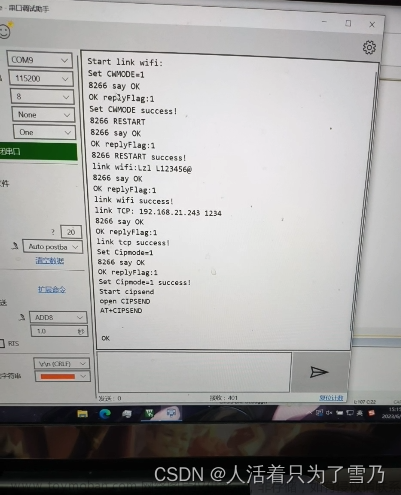
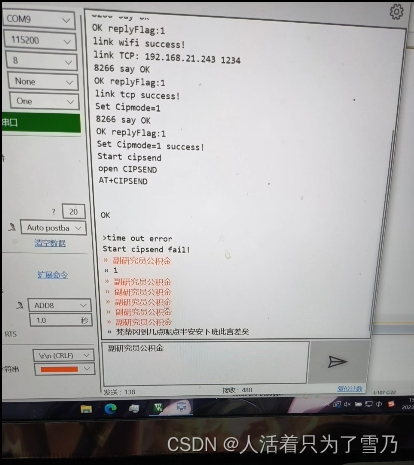
五、相关问题
1.正常情况下,在中断回调函数的延时函数是会出现问题的
详细请参考:(STM32 HAL库 中断处理中使用延时函数(HAL_Delay)_中断中延时_Dir_xr的博客-CSDN博客
所以我们在主函数里写一个延时函数
2.当给8266发送重启或者恢复出厂化等一些指令时,8266在回复OK后,还会回复一些其他东西,其中就有些乱码,导致的问题是,接收到2个字符的乱码,无法进入中断回调函数,但是会失能你的接收,所以就没法再接收8266的信息了,就要再次使能接收才行。你可以进入测试模式,或者直接硬件连接8266与其直接通信,看看效果。
这个问题我一直都还不懂怎么解决,我采用的方法是延时一段时间,等OK后的乱码消息发送完后再使能接收,治标不治本,后面解决了会更新这篇文章。
3.对于不同指令,8266回复时间不一样,也就是说有些能很快收到OK或者ERROR,有些就不行,代码里我给的是40s内,如果后面出现replayFlag与你想要的效果不一样,可以取消掉我那几条pintf和那个臭狗屎代码来测试问题在哪,大概率是时间问题,改成40s以上应该会解决,看个人实际情况,来修改我代码中的一些延时来提高通信速率。
总结
相关的app和源码
链接:https://pan.baidu.com/s/17Lzfma5iekRKTS21OrY9Qg?pwd=0407
提取码:0407
以上本文的内容,只是简单的与手机APP通信,后续会更新stm32hal库与其他外设的使用或者其他内容,有什么疑问可以私信。文章来源:https://www.toymoban.com/news/detail-761498.html
如果这对你有用的话,麻烦点赞+收藏,这对我来说真的重要文章来源地址https://www.toymoban.com/news/detail-761498.html
到了这里,关于入门stm32:STM32hal库实现ESP8266与手机通信(不定长数据收发和ESP8266使用的一些问题)的文章就介绍完了。如果您还想了解更多内容,请在右上角搜索TOY模板网以前的文章或继续浏览下面的相关文章,希望大家以后多多支持TOY模板网!


